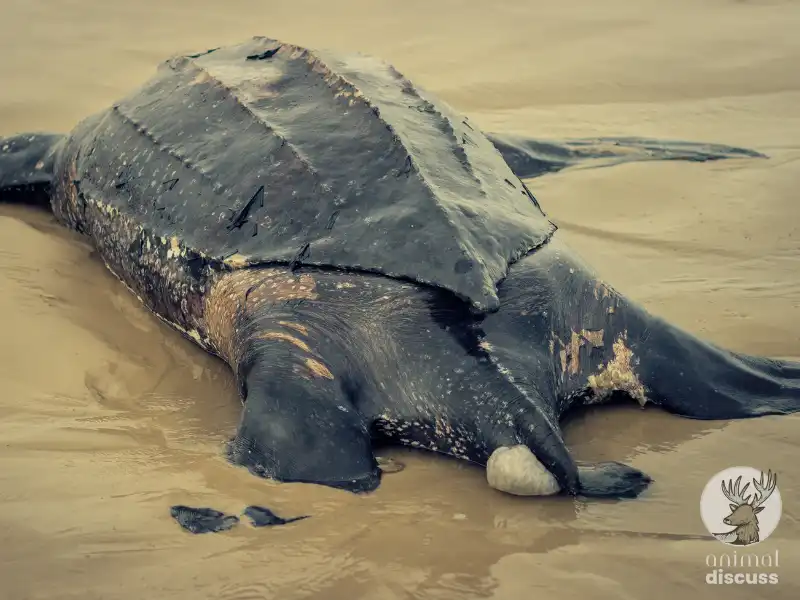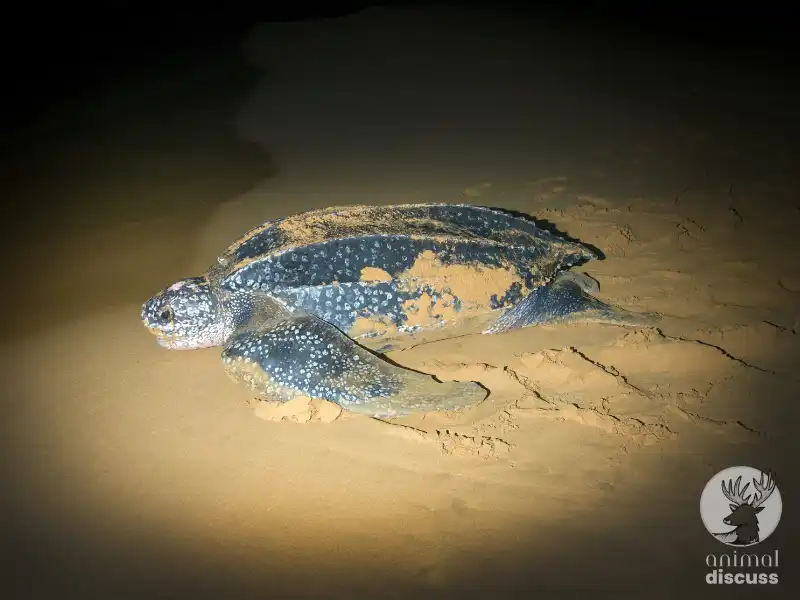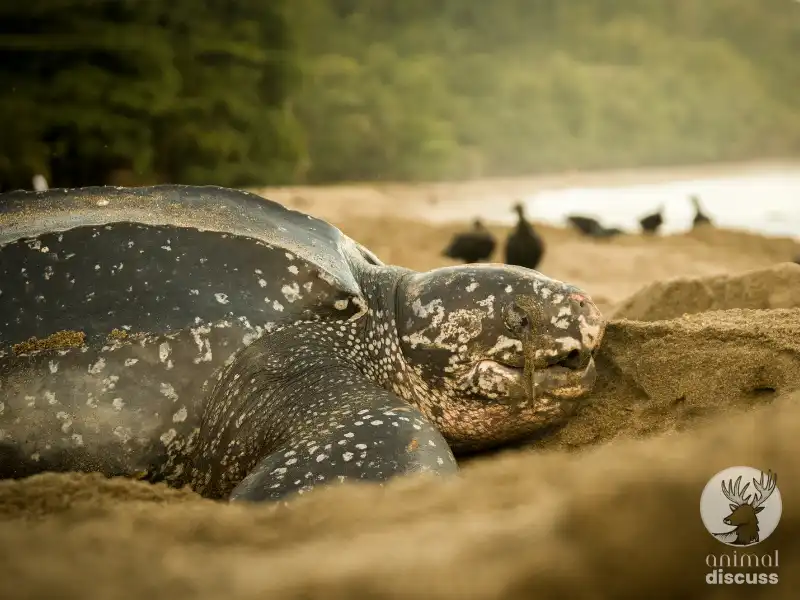Does one place in the ocean be the habitat of the Leatherback Sea Turtle? No, because they migrate frequently according to their needs. For instance, they move from one place to another for food, temperature, breeding, nesting, etc.
After that, they are mostly found in the coastal areas. Also, they travel to northern and southern areas which are unexplored by other turtles. They are unique in nature as a deep diver along with their migration.
We will delve deeply into the world of leatherback sea turtles in this blog article, discussing their feeding grounds, nesting locations, mating habits, and conservation measures.
Stay tuned to explore the secrets of their preferred habitats.
Foraging Grounds and Habitat Choice: Where Do They Live? [Reference]
The huge foraging range and long-distance migrations of leatherback sea turtles are well-known. These amazing animals can be found in the Pacific and Atlantic oceans, among other waters worldwide.

But what factors influence them to choose the selected habitat? Well, the availability of prey, water temperature, climate change and ocean currents all affect the habitat choices of leatherback sea turtles.
It helps with digestion and energy conservation as these turtles exhibit a preference for warmer climates.
So, one common question according to variation of climate and their adaptation capability is, do leatherback sea turtles survive in low temperatures? Yes, below 40 degrees Fahrenheit, leatherback sea turtles can survive in the ocean.
In this regard, these turtles can easily adapt to every environment based on their needs.
To know more about Leatherback Sea Turtle
Nesting Habitats and Site Selection of Leatherback Sea Turtles [Reference]
To lay their eggs, leatherback sea turtles need particular settings for nesting. Comprehending these nesting preferences is crucial for their preservation.
Some major nesting areas and site-choosing factors are discussed below:
Coastal Areas
Leatherbacks prefer sandy beaches with mild slopes for nesting. Likewise, you can find their nesting on the Pacific coast of Mexico and Costa Rica and the eastern tropical Pacific Ocean.
The ideal conditions for egg incubation and successful hatchlings are found in these places. Also, for leatherback sea turtles to survive, nesting beaches must be protected.
Environmental Factors Influencing Nesting Site
A number of environmental factors influence the selection of nesting locations. These include the ocean’s closeness, the temperature, and the quality of the sand.
Climate change is a major hazard to the survival of hatchlings. Because the temperature of the sand determines their survival.
Where Do Leatherback Sea Turtles Breed and Nest?
The breeding and nesting period is critical for every animal and so is for the leatherback sea turtle.
During the mating and reproduction period, male leatherbacks fiercely compete with females for their attention during complex mating rituals. Female leatherbacks return to their nesting beaches to deposit their eggs after mating.

Leatherbacks mate in shallow waters near their nesting habitat, offshore. In the area with vegetation, on sloping sandy beaches the females construct their flask-shaped nests at night.
Do you have any idea about leatherback mating rituals? Well, every two to three years, female leatherbacks build multiple nests during a single nesting season.
A deep hole must be dug in the sand, a clutch of eggs must be laid, and the nest must be securely covered to keep out predators throughout each nesting event.
For example, a season can produce up to six clutches, with a 10-day interval between nesting. Up to seven miles can pass between the females’ first and second nests.
An average clutch has between 80 and 85 eggs, and it takes between 55 and 74 days to hatch.
What Endangers the Habitats of Leatherback Sea Turtle?
It’s nowadays a common threat for every living species in the world to face habitat challenges. Leatherback sea turtles face the same and they must overcome those obstacles to save their habitat.
Some major threats to leatherback sea turtles’ habitat are given below:
Bycatch in fishing gear
For these threatened species, accidental entanglement in nets and lines meant for commercial species like swordfish and tuna. Their entanglements damage marine habitats like leatherback sea turtles and cause injuries, breathing difficulties, and death.
Human impacts
The habitats of leatherback sea turtles are seriously threatened by human activities such as pollution, coastal development, and careless fishing methods. Human development frequently results in the destruction or modification of prime breeding grounds, which commonly occur in coastal environments.
Illegal harvesting of eggs
One major threat to the survival of these magnificent animals is the illicit collection of leatherback sea turtle eggs. Also, by taking advantage of nesting locations under the cover of darkness, poachers deny future generations the opportunity to flourish and continue their downward trend.
Climate change effects
The capacity of leatherback sea turtles to lay their eggs may be impacted by nesting beaches. Also, it is being submerged due to rising sea levels brought on by climate change. Thus, their eating habits and the availability of prey can be affected by variations in water temperature.
Pollution and habitat degradation
Leatherback sea turtles are seriously threatened by marine pollution, especially from plastic waste and oil spills. These animals frequently confuse plastic bags for their favorite food, which leads to ingestion and death.
The devastation of coral reefs and other forms of habitat degradation put their feeding sites even more at risk.
Conservation Efforts to Preserve the Habitat of Leatherback Sea Turtles
International agreements, community-based programs, and research and education initiatives are all necessary to preserve the habitat of leatherback sea turtles.
The main goals of conservation initiatives are to lessen human disturbance, establish beach monitoring programs, and increase public understanding of the need to protect these vital habitats.

Moreover, for the sake of leatherback sea turtle conservation, it is essential to comprehend the species’ preferred habitats. We can put into place efficient conservation plans to save these vital habitats by locating their feeding areas and breeding locations.
Besides, these are the measures that should be strictly considered-
International agreements and protections
The conservation of leatherback sea turtles is a top priority for international organizations, such as the Convention on International Trade in Endangered Species (CITES), through agreements and laws.
These initiatives seek to lessen the negative effects of human activity on wildlife habitats, establish protected areas, and control commerce.
Local conservation initiatives
The people who live close to the habitats of leatherback sea turtles are essential to their conservation. These locals are given the tools they need through community-based conservation projects to safeguard nesting beaches, keep an eye on population trends, and advance eco-friendly travel.
Research and education efforts
Understanding the ecological choices and habits of leatherback sea turtles requires ongoing study and educational initiatives. We can encourage a worldwide commitment to preserving these amazing animals by increasing awareness of the value of conservation.
Frequently Asked Questions
Let’s have a look at some frequently asked questions regarding the habitat of Leatherback Sea Turtle:
Are leatherback sea turtles endangered?
Yes, leatherback sea turtles are listed as endangered by the International Union for Conservation of Nature (IUCN) due to population declines caused by human activities.
How long do leatherback sea turtles live?
Leatherbacks have a long lifespan, with some individuals living up to 45 years or more.
Conclusion
The habitat of leatherback sea turtles totally depends on their needs. For instance, their foraging range, nesting, mating, and reproduction are the most important factors. Moreover, the temperature, water depth, etc. also influence them to choose their habitat.
On the other hand, we must take every precaution to preserve the vulnerable and complicated ecology that serves as the home for leatherback sea turtles. Together, let’s make sure that these amazing animals, who have been cruising our seas for millions of years, survive.

